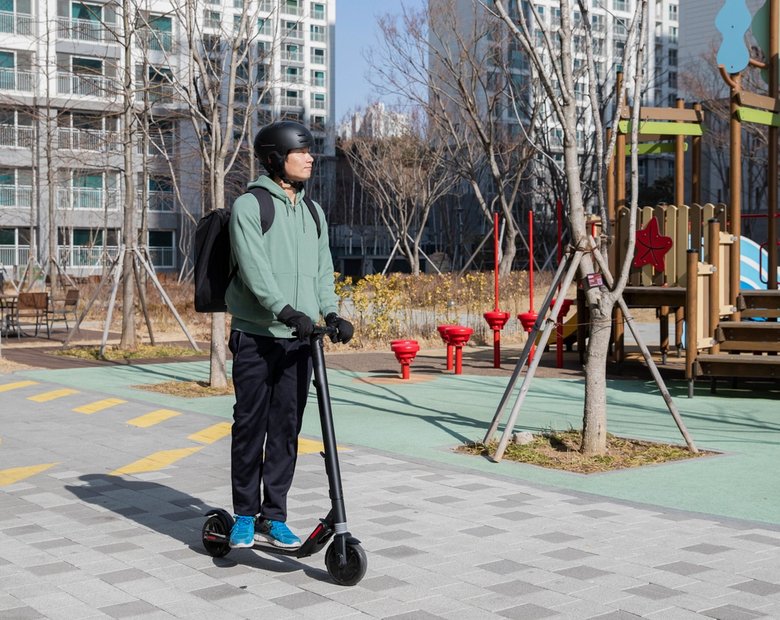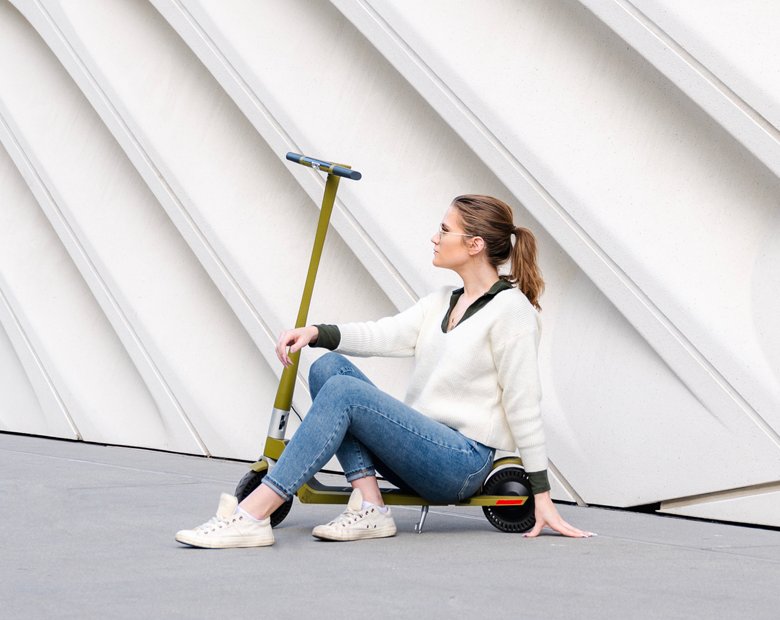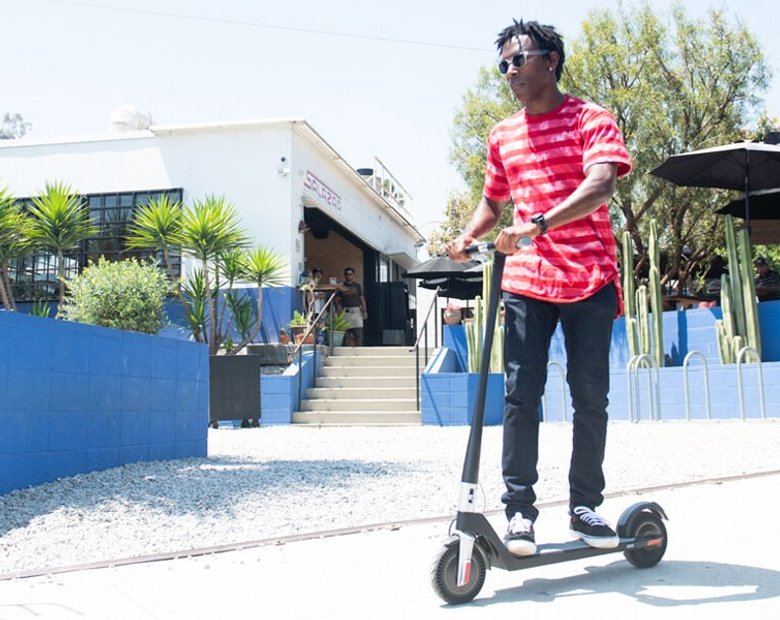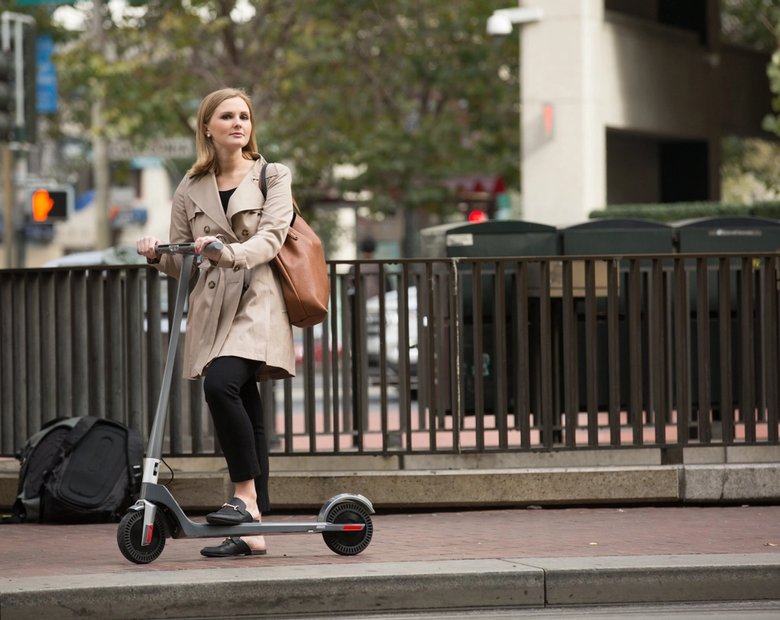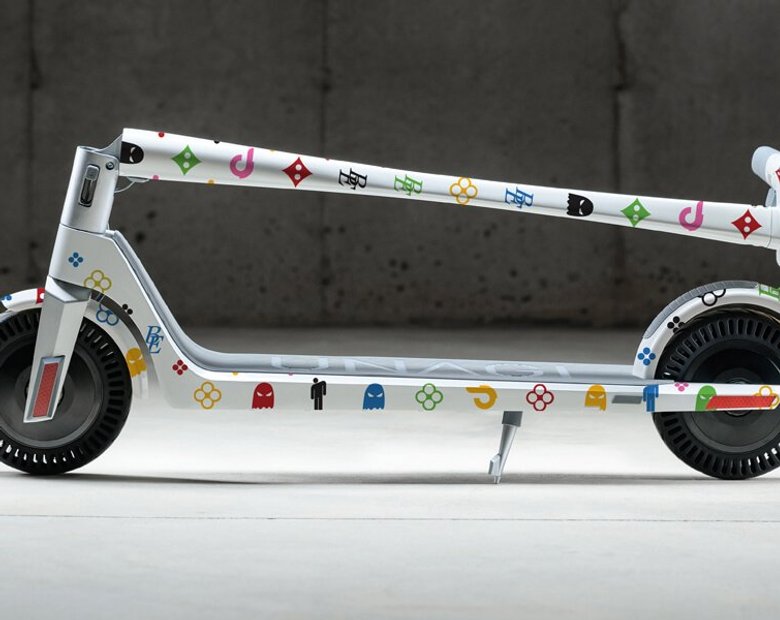"Can I make my electric scooter waterproof?"
Yes, you can. It's definitely worth it. It will help extend the lifespan* of your e scooter. From applying a silicone solution and waterproofing spray to a robust, conformal coating.
*The average lifespan of a personal electric scooter is around three years. (Less for some budget scooters).
Difference between "water resistance" and "waterproof"
It's often stated the best electric scooters have strong water resistant features.
It can sometimes be the case that water resistant e scooters are not fully waterproof. There is a difference:
- Water resistance - capable of resisting water penetration to a certain level but not always completely.
- Waterproof - a completely secure barrier against water penetrating, no matter how long submerged or exposed to water.
Some electric scooters approved for water resistance
Your electric scooter will have an Ingress Protection (IP) rating. This is a standardized code used on all modern scooters. It tells you the level of protection your electric scooter has against liquids such as water (and solid objects, such as dust) - under controlled test conditions. Each IP rating is explained later in this article.
It may mean the average electric scooter is approved for a level of water resistance only.
The protection given under its IP rating may need boosting to become more securely waterproof.
Protect against wet conditions in your state

Whatever your scooter's IP rating there are further ways you can easily waterproof your electric scooter to be even more water resistant. To better withstand rainy or bad weather.
Especially, if you live in the 10 rainiest states, with 60 - 90 percent higher than average rainfall:
- Hawaii - Louisiana - Mississippi - Alabama - Florida - Tennessee - Georgia - Arkansas - North Carolina - South Carolina.
(Source: WorldAtlas, April 2019)
Extend scooter lifespan for up to 5 years
A waterproof electric scooter is more likely to have a longer corrosion-free life than a basic water resistant e scooter.
Even if you're not living in a state with high rainfall or a wet climate, it pays to waterproof your electric scooter. It can help to:
- Protect electric components from water damage.
- Save on costly damage repair and maintenance.
- Extend scooter lifespan for up to 5 years.
We can all get caught out by unexpected rainfall.
But what happens if you're repeatedly riding in wet conditions during the long autumn and winter months? Particularly, if you use your scooter for the daily urban commute?
The best waterproof electric scooters will boost protection and prolong performance. This article will give you more than a few tips and tricks to make electric scooters waterproof.

Sensitive electrical components
Electric scooters have sensitive electronic components, including battery, motor, cockpit control, wiring and connectors.
- Riding your electric scooter in rainy weather or on wet surfaces - may mean constant exposure to water splashes or puddles.
- Riding your electric scooter in heavy rain - increases the likelihood of water entering the scooter's vulnerable areas.
Whenever you're riding your scooter in the rain or generally bad weather, the exposure and contact with water can lead to short circuits, electrical damage and longer term corrosion.

IP rating - each protection level explained
Your electric scooter is issued with an IP rating.
IP stands for Ingress Protection - how much resistance to liquids or solid objects (such as dust or larger particles) from "entering" an "enclosure".
An "enclosure" will typically include:
- Scooter frame
- Handle bars and folding stem
- Wheel hubs, motor wheel axles, suspension
- Motor
- Battery
- Electrical system - wiring, connectors
- O-rings (gaskets for non sealed screws, and joins between separate parts - to prevent leaks)
- Other internal components
- Non functional holes and spaces
IP rating numbers - what they mean
Following the letters IP of your scooter's rating:
- 1st number - indicates level of protection against solid objects.
- 2nd number - indicates level of protection against liquids.
1st number - solid objects
There are 6 levels of protection:
- IP0X - No protection.
- IP1X - 50mm and above (e.g, accidental touch by a hand).
- IP2X- 12.5mm and above (e.g, fingers).
- IP3X- 2.5mm and above (e.g, tools, thick wires).
- IP4X - 1mm and above (e.g, small tools, wires).
- IP5X- Limited dust protection (but must not interfere with component function).
- IP6X - Full protection.
2nd number - liquids
There are 9 levels of protection:
IPX0 - No protection.
IPX1 - Vertically falling water drops (e.g, condensation).
IPX2 - Vertically falling water drops when scooter tilted up to 15 degrees.
IPX3 - Sprays of water up to 60 degrees from vertical.
IPX4 - Water splashes from any direction.
IPX5 - Low-pressure water jets from any direction.
IPX6 - High-pressure water jets or heavy waves.
IPX7 - Under water by up to 1 meter for 30 minutes.
IPX8 - Under water continuously, according to manufacturer specifications.
IPX9K - High-pressure and high-temperature water jets (typically used for industrial equipment).
Check with the manufacturer's specifications for your electric scooter make and model. It should ideally be issued with a minimum IP rating of IPX4 - water splashes from any direction.
This rating gives your scooter a reasonable level of protection against water splashes and light rain.
Example: the Unagi Model One (E500) has an IP rating of IP54.
It means this electric scooter - designed and built for the urban commute - is protected against water splashes and light rain, and dust particles interfering with components functioning.
IMPORTANT: IP ratings only indicate the level of protection carried out under specific test conditions.
It may not give an accurate and reliable picture of how water-resistant your scooter actually is on the daily urban commute - in your state or local area - and throughout the year.
Even electric scooters with a high IP rating can be vulnerable to riding in heavy rain. Let's look in more detail how to reduce the risk of water damage to your electric scooter.
Top tips on how to waterproof your electric scooter
Read the manufacturer's guidelines
"Who bothers doing that?", you may be thinking. But before you start, it IS essential you check out the manufacturer's recommendations and guidelines for waterproofing your specific, electric scooter model. It's important for better understanding any vulnerabilities to water splashing your particular scooter may have.
Look for those hidden vulnerable areas
Next, get up close and personal with your e scooter. Thoroughly inspect everywhere you can, and look for those hidden, vulnerable areas. You may find tiny, little spaces that could let in water, such as the wheel hubs, motor wheel axle, battery compartment, connectors, handlebar controls, and battery charging port.

Apply a silicone sealant
If you're up for getting more hands-on... silicone spray sealants create an added waterproof barrier around vulnerable areas of an electric scooter.
Preparation - before applying silicone sealant
- Make sure your scooter is powered off, and disconnected from any mains-power sources.
- Carefully inspect your electric scooter for any gaps, loose connections or exposed wiring.
Application of silicone sealant
- Carefully and steadily apply the silicone spray solution to any potential vulnerable areas of the scooter, which could be the battery compartment, cockpit control, and battery charging port
- Also apply to any tiny openings you find, to prevent even the smallest water droplets from seeping in. Small, non-functional holes* can often be found on electric scooters, including: underside or sides of the deck, along the stem, around handlebars and tail light screws.
- Non-functional holes: To ensure a small hole is non-functional, raise your scooter wheels right off the ground, then press the throttle to check if air is coming in or out of the hole.
- Finally, allow the sealant to completely cure and dry before riding your scooter.
Apply a silicone-based conformal coating
A next-level, pro technique. This special type of coating is designed to beef up the protection to your electric scooter's printed circuit board (PCB), and other electronic components.
The protective coating of thin, polymeric (large molecule) film is called "conformal" because it conforms to (and wraps around) the shape of the PCB. It's specifically made to waterproof electronics against moisture, dust, and other contaminants.
Conformal coatings also provide added insulation against thermal shock, static, and vibration.
Silicone Resin (SR) coatings give high-level moisture (and salt spray) protection across a very wide temperature range. For this reason they are commonly used in high humidity environments.
Preparation - before applying a conformal Coating
- Ensure your scooter is powered off, and disconnected from any mains-power sources.
- Remove any covers or enclosures allowing access to the electronic components.
- Thoroughly clean the surfaces of the PCB and its components, using a mild electronics cleaner or isopropyl alcohol (sometimes called "rubbing" alcohol"). The aim is to remove any contaminants such as dust, dirt, or oils, which could prevent the conformal coating making a secure bond.
Application of a Conformal coating
- Choose a well-ventilated area to prevent the breathing-in of any potentially harmful fumes.
- Shake the conformal coating can or bottle as per the manufacturer's instructions to ensure contents are properly mixed.
- Apply a thin, even layer of silicone sealant - without causing excessive pools or drips. IMPORTANT: Ensure you avoid coating connectors, switches, or other parts that make direct electrical contact.
After coating is applied
- Leave the conformal coating to fully cure and dry, according to the manufacturer's recommended time period. It could be a few minutes or several hours. In many cases, it's best to leave for at least 12 hours or overnight.
- Ensure your electric scooter is placed in a clean and dust-free environment until the curing/drying process is completed.
- Once the coating is fully dry, carefully inspect all surfaces for any spots or areas you may have missed for recoating.
- After a final inspection, reassemble your scooter, ensuring all connections are secure and proper insulation maintained.
Other types of non-silicone based conformal coatings are:
Acrylic Resin (AR) - good overall protection, with high dielectric strength*, and reasonable moisture resistance.
*Dielectric strength - strength of an electrical insulating material. A measure of the maximum voltage withstood before insulation breaks down and becomes conductive (allows electricity to flow).
Urethane (Polyurethane) Resin (UR) – superior moisture resistance. Also chemical and solvent resistant.
IMPORTANT: You should only apply a conformal coating if you have a good working knowledge of electronics and familiar with your scooter's layout. It's always recommended to contact the scooter manufacturer for guidance. Or seek advice and help from a qualified electrical technician or engineer.

Apply dielectric grease to connectors
Apply dielectric* grease to the metal parts of any electrical connections that may still be exposed, which will protect from corrosion and contamination.
.*Dielectric - means it does not conduct electricity. Dielectric grease is a fluid form of electrical insulation that's squeezed from a tube.
Dielectric grease is often used in electrical systems to prevent moisture from entering. It can also withstand extreme heat which means it can stop plastic and rubber parts from fusing together.
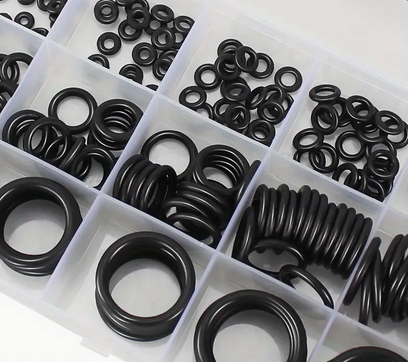
Use O-rings around non-sealed screw holes
IMPORTANT: This is different from applying silicone sealant to seal non-functioning holes.
Water can typically enter and travel down any unsealed hole drilled out for screws, bolts, cables or wires.
Here the aim is to make holes for non-sealed screws - and those with cables and wires fed through - resistant to water entering and causing short circuits, and corrosion.
Ensure your O-rings are specifically designed for water resistance, are the correct size, compressed precisely and tightly in the grooves.
Care and maintenance of O-rings
Use a soft cloth and a mild detergent only (not abrasives or brushes) to keep the O-rings and its surrounding areas clean and free from debris.
Apply a thin layer of silicone-based lubricant to help maintain a tight and flexible seal.
O-rings should be regularly checked for signs of wear, damage, or deterioration, and properly seated in place.

More easy tips to quickly seal small holes
Insert waterproof plugs or grommets
These plugs are are made of water-resistant materials specifically designed for sealing non-functional holes.
Rubber or silicone caps
A really small non-functional hole can be sealed with a rubber or silicone cap to prevent water or moisture from seeping in.
Temporary/emergency measures
Sometimes you can be caught by an unexpected downpour just before setting out on your daily commute or while riding. You may suddenly notice water entering in or coming out of a tiny hole or other gap.
Try these instant fixes to temporarily stop the water entering non-functional holes, and leading to internal corrosion.
Adhesive patches
Larger non-functional holes or gaps can be covered with a "cut to fit" waterproof adhesive patch.
Duct tape solution
A good tip is to always carry duct tape whenever you ride. It's such a simple solution - but remember - duct tape may be a versatile adhesive tape but it's not designed specifically for reliable and permanant waterproofing.
It's definitely a temporary fix only for stopping water you suddenly see entering a hole or gap. Or securing a loose cable or wire.
Typical examples include:
Ride deck
Some e scooters may have electrical wires visible at the edges of the deck. Simply cover with duct tape matching your scooter colour to protect from rain, puddles and water splashes.
Battery charging port
Your battery charging port may have a protective cap. But it can still be one area of your scooter that's most vulnerable to water getting in when riding in wet weather. Particularly, if the port is positioned lower and closer to the ground.
Quickly cover with duct tape, and prevent water entering. It could lead to problems affecting your scooter's battery life and charging capability.
IMPORTANT: A more permanent and robust waterproofing measure should be applied as soon as possible.
Waterproofing cockpit control
Your electric scooter power button, LED screen and throttle paddle can also be prone to letting in moisture. Here are a couple of easy, low-cost tips to instantly waterproof these vital components of cockpit control:
Transparent sticky plastic covers
The type of transparent plastic cover you would normally find attached to the screen of a new cellphone or other electronic device - are ideal for quickly sealing over a LED screen on your cockpit control.
You will first need to clean the screen surface with a mild detergent and water.
After the screen is completely dry remove the backing from the sticky plastic cover and carefully apply to the surface.
It's important to smooth out any air bubbles trapped underneath by using a soft cloth. The LED readout function needs to be clearly visible and not obscured.
Remove any excess plastic using a sharp utility knife to ensure you have a clean and precise fit.
Normal adhesive tape
Standard adhesive can be quickly applied to protect the power button. You can also use adhesive tape to wrap around a throttle paddle for added waterproofing.
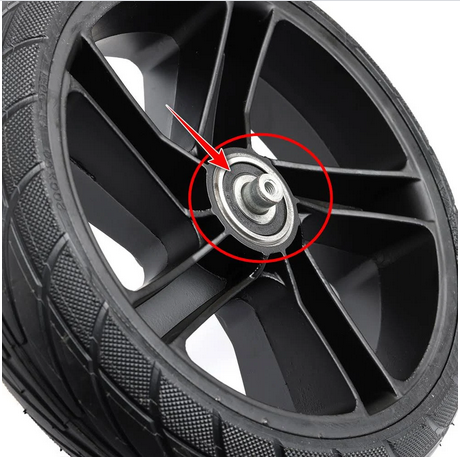
Waterproofing the motor wheel axles
Motor wheel axles should always be included in any waterproofing to give added protection to your scooter's internal motor components. It will involve applying thick grease to the axles.
What to do before you start...
Firstly, you will need to remove the wheels -by following the manufacturer's instructions. Your model of electric scooter may have motors in either the front wheel, the back wheel, or both. Grease will need to be applied in each case.
Then thoroughly clean the axles. It's particularly important to remove any dirt, debris, or grease that may have built up. You only need to use a mild detergent dissolved in water.
Greasing the wheel axles
Now you can apply a thin layer of water-resistant silicone grease or dielectric grease to the motor wheel axles.
Once the axles are properly greased, put the wheels back on. Once again, you need to follow the manufacturer's instructions and ensure both wheels are properly aligned and securely attached.
Cleaning maintenance and storage tips for added protection
Use a waterproof cover
A waterproof cover is an effective way to protect your electric scooter from rain and other wet weather conditions when it's not in use.
You need to use a cover specifically designed for electric scooters. This should be the right size and dimensions to give a close, secure fit. Your waterproof cover should also be made from durable materials, such as polyester with a waterproof coating.
It's important to make sure it covers the entire scooter, including the wheels and handlebars, to give complete protection.
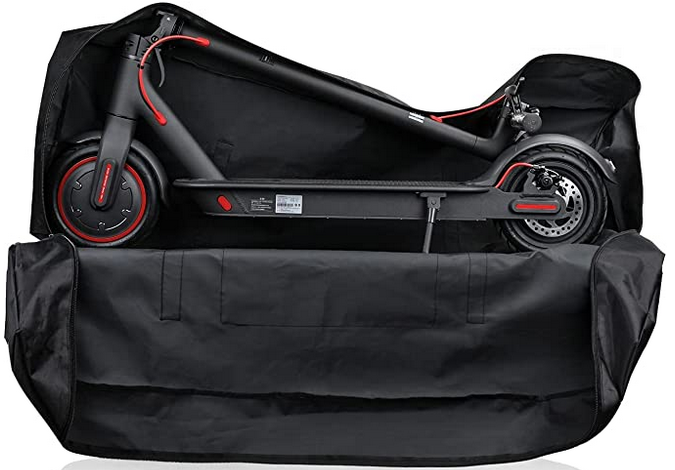
Carry in a waterproof bag or pouch
If you intend to ride in rainy weather or generally wet conditions, a good tip is to use waterproof bags or pouches to carry your electric scooter in between rides. For example, when you need to access public transport, use stairs or elevators.
Waterproof bags will give you an extra layer of protection against water and moisture, for keeping your scooter dry.
When you return from riding in heavy rain it's important to:
1. Thoroughly dry your scooter.
Wet scooters need to be actively dried straightaway. Not left dripping outside, or inside.
To remove any water and surface moisture you should first, power off the scooter and disconnect the battery, if possible.
Next:
- Wipe down your scooter frame with a dry cloth straightaway.
Focus particular attention on:
- Handlebars and cockpit controls
- Battery compartment
- All electronic components, cables and wiring
- Lighting and reflector housing, and LED strips
2. Fold the scooter correctly
It's critical to fold your electric scooter correctly so it dries out properly.
This means ensuring the handlebar is raised above the stem when folded and stored.
It's important to prevent drops of water trickling down the stem and onto the LED screen, and throttle paddle of the handlebars.

Use a wetdry vacuum cleaner
A wetdry vacuum cleaner is designed to not only remove dust and solid debris. It can also deal effectively with removing excess water or moisture from many types of surfaces. Including the body of your electric scooter.
To avoid any damage to your scooter, it's important to follow these safety steps:
- Before you start, check to ensure your scooter is powered off and disconnected from any power sources.
- Remove excess water manually using absorbent towels or cloths, especially the battery compartment, and handlebar control panel.
- Select the right nozzle attachment for the size and shape of each of the scooter areas you want to dry.
- At first, use the lowest suction setting to avoid causing damage, then gradually increase power if needed but still be careful around sensitive electronics.
- Always move the nozzle gently over your scooter's wet areas and avoid excessive pressure or prolonged contact.
- Lastly, thoroughly dry your scooter again using dry towels or cloths to wipe down all surfaces, and leave to air dry completely before powering up for your next ride.
Use low pressure water jets
A low pressure water jet is useful for removing excess dirt, mud and debris. You must ensure the water jet or hose is at a low-pressure setting to avoid damaging your scooter's waterproofing. IMPORTANT: Avoid spraying water directly into the battery charging port, and allow enough time to completely dry before using again.
Regular inspection and maintenance
It's important to regularly inspect for any signs of wear and damage, caused by water or moisture. Similarly, maintain your waterproofing measures, particularly, seals, sealants, holes and coverings.
Final tip...
The above tips and techniques for maximising your electric scooter's waterproofing aims to keep you and your scooter safely riding for longer than many scooters not waterproofed in the same way.
However, it's always best to avoid riding in heavy rain or really bad weather if you don't have to. Even more so in the winter months, where your scooter will be faced with snow, ice - and salt, a fast-acting corrosive.
If you have to take your e scooter out in rainy or bad weather - try to avoid those puddles and muddy spots on the pavement and tarmac ahead of you.












